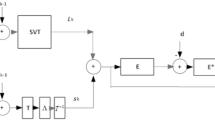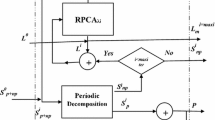Abstract
Introduction
Cardiac magnetic resonance imaging (cMRI) is a standard method that is clinically used to evaluate the function of the human heart. Respiratory motion during a cMRI scan causes blurring artefacts in the reconstructed images. In conventional MRI, breath holding is used to avoid respiratory motion artefacts, which may be difficult for cardiac patients.
Materials and Methods
This paper proposes a method in which phase correlation-based binning, followed by image registration-based sparsity along with spatio-temporal sparsity, is incorporated into the standard low rank + sparse (L+S) reconstruction for free-breathing cardiac cine MRI. The proposed method is validated on clinical data and simulated free-breathing cardiac cine data for different acceleration factors (AFs). The reconstructed images are analysed using visual assessment, artefact power (AP) and root-mean-square error (RMSE). The results of the proposed method are compared with the contemporary motion-corrected compressed sensing (MC-CS) method given in the literature.
Results
Our results show that the proposed method successfully reconstructs the motion-corrected images from respiratory motion-corrupted, compressively sampled cardiac cine MR data, e.g., there is 26% and 24% improvement in terms of AP and RMSE values, respectively, at AF = 4 and 20% and 16.04% improvement in terms of AP and RMSE values, respectively, at AF = 8 in the reconstruction results from the proposed method for the cardiac phantom cine data.
Conclusion
The proposed method achieves significant improvement in the AP and RMSE values at different AFs for both the phantom and in vivo data.








Similar content being viewed by others
References
Usman M et al (2013) Motion corrected compressed sensing for free-breathing dynamic cardiac MRI. Magn Reson Med 70(2):504–516
Hamilton J, Franson D, Seiberlich N (2017) Recent advances in parallel imaging for MRI. Prog Nucl Magn Reson Spectrosc 101:71–95
Ricardo O et al (2010) Combination of compressed sensing and parallel imaging for highly accelerated first-pass cardiac perfusion MRI. Magn Reson Med 64(3):767–776
Feng L et al (2013) Highly accelerated real-time cardiac cine MRI using k–t SPARSE-SENSE. Magn Reson Med 70(1):64–74
Anagha D et al (2012) Parallel MR imaging. J Magn Reson Imaging 36(1):55–72
Ahmed AH et al (2017) Motion correction-based reconstruction method for compressively sampled cardiac MR imaging. Magn Reson Imaging 36:159–166
Barkhausen J et al (2002) Assessment of ventricular function with single breath-hold real-time steady-state free precession cine MR imaging. Am J Roentgenol 178(3):731–735
Kellman P et al (2009) High spatial and temporal resolution cardiac cine MRI from retrospective reconstruction of data acquired in real time using motion correction and resorting. Magn Reson Med 62(6):1557–1564
Axel L, Otazo R (2016) Accelerated MRI for the assessment of cardiac function. Br J Radiol 89(1063):20150655
Setser RM, Fischer SE, Lorenz CH (2000) Quantification of left ventricular function with magnetic resonance images acquired in real time. J Magn Reson Imaging 12(3):430–438
Kellman P, McVeigh ER (2001) Adaptive sensitivity encoding incorporating temporal filtering (TSENSE). Magn Reson Med 45(5):846–852
Breuer FA et al (2005) Dynamic auto-calibrated parallel imaging using temporal GRAPPA (TGRAPPA). Magn Reson Med 53(4):981–985
Liu J et al (2017) Highly-accelerated self-gated free-breathing 3D cardiac cine MRI: validation in assessment of left ventricular function. Magn Reson Mater Phy 30(4):337–346
McLeish K et al (2002) A study of the motion and deformation of the heart due to respiration. IEEE Trans Med Imaging 21(9):1142–1150
Ding Yu et al (2011) A new approach to auto-calibrated dynamic parallel imaging based on the Karhunen–Loeve transform: KL-TSENSE and KL-TGRAPPA. Magn Reson Med 65(6):1786–1792
Hansen MS et al (2012) Retrospective reconstruction of high temporal resolution cine images from real-time MRI using iterative motion correction. Magn Reson Med 68(3):741–750
Bilal M et al (2018) Respiratory motion correction for compressively sampled free breathing cardiac MRI using smooth-norm approximation. Int J Biomed Imaging 2018
Kellman P, Chefdhotel C, Lorenz CH, Mancini C, Arai AE, McVeigh ER (2008) Fully automatic, retrospective enhancement of real-time acquired cardiac cine MR images using image-based navigators and respiratory motion-corrected averaging. Magn Res Med 59:771–778
Feng L, Axel L, Chandarana H, Block KT, Sodickson DK, Otazo R (2016) XD-GRASP: golden-angle radial MRI with reconstruction of extra motion-state dimensions using compressed sensing. Magn Reson Med 75(2):775–788
Otazo R, Candes E, Sodickson DK (2015) Low-rank plus sparse matrix decomposition for accelerated dynamic MRI with separation of background and dynamic components. Magn Reson Med 73(3):1125–1136
Foroosh H, Zerubia JB, Berthod M (2002) Extension of phase correlation to subpixel registration. IEEE Trans Image Process 11(3):188–200
Vercauteren T et al (2009) Diffeomorphic demons: Efficient non-parametric image registration. NeuroImage 45(1):S61–S72
Kroon DJ, Cornelis HS (2009) MRI modality transformation in demon registration. 2009 IEEE international symposium on biomedical imaging: from nano to macro. IEEE
Thirion J-P (1998) Image matching as a diffusion process: an analogy with Maxwell's demons. Med Image Anal 2(3):243–260
(ISMRM 2014) Motion-guided low-rank plus sparse (L+S) reconstruction for free-breathing dynamic MRI. https://archive.ismrm.org/2014/0742.html. Accessed 23 Jul 2018
Jung H et al (2009) k-t FOCUSS: a general compressed sensing framework for high resolution dynamic MRI. Magn Reson Med 61(1):103–116
Wissmann L et al (2014) MRXCAT: realistic numerical phantoms for cardiovascular magnetic resonance. J Cardiovasc Magn Reson 16(1):63
Fessler JA (2007) On NUFFT-based gridding for non-Cartesian MRI. J Magn Reson 188(2):191–195
Aslam I, Najeeb F, Omer H (2018) Accelerating MRI using GROG gridding followed by ESPIRiT for non-Cartesian trajectories. Appl Magn Reson 49(1):107–124
Author information
Authors and Affiliations
Corresponding author
Ethics declarations
Conflict of interest
Faisal Najeeb declares that he has no conflict of interest. Muhammad Usman declares that he has no conflict of interest. Ibtisam Aslam declares that he has no conflict of interest. Sohaib Ayaz Qazi declares that he has no conflict of interest. Hammad Omer declares that he has no conflict of interest.
Ethical approval
All the procedures performed in the studies involving human participants were in accordance with the ethical standards of the institutional and/or national research committee and with the 1964 Helsinki Declaration and its later amendments or comparable ethical standards.
Informed consent
Informed consent was obtained from all the individual participants included in the study before data acquisition.
Additional information
Publisher's Note
Springer Nature remains neutral with regard to jurisdictional claims in published maps and institutional affiliations.
Rights and permissions
About this article
Cite this article
Najeeb, F., Usman, M., Aslam, I. et al. Respiratory motion-corrected, compressively sampled dynamic MR image reconstruction by exploiting multiple sparsity constraints and phase correlation-based data binning. Magn Reson Mater Phy 33, 411–419 (2020). https://doi.org/10.1007/s10334-019-00794-8
Received:
Revised:
Accepted:
Published:
Issue Date:
DOI: https://doi.org/10.1007/s10334-019-00794-8




